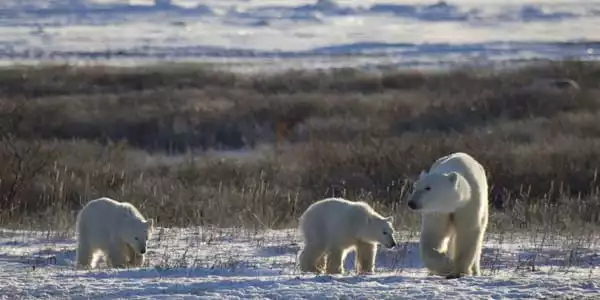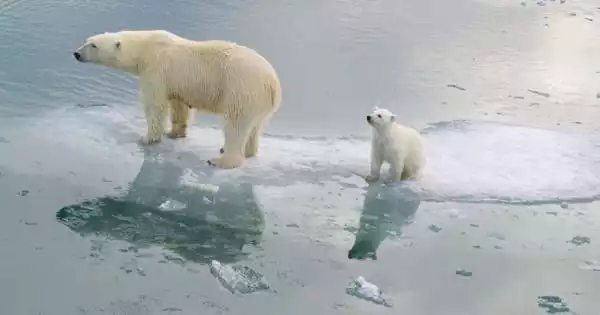Polar bears are the world’s largest land-based carnivores, despite spending the majority of their lives near water and ice. As a result, they are particularly vulnerable to global warming, which is melting the Arctic sea ice on which they rely. They usually live and hunt alone, but they can be quite social as well. They primarily eat seals, and their extraordinary sense of smell allows them to detect a seal in the water beneath a meter of compacted snow from nearly a kilometer away.
How are rising temperatures and melting sea ice affecting Arctic polar bears and their marine mammal prey? A research team led by York University took a novel approach to the question by tracking what polar bears eat and where they catch their prey across Nunavut. They discovered that polar bears can be used as environmental indicators, highlighting how these changes are disrupting the normal distribution of marine mammal prey populations in the Arctic.
The researchers, led by Ph.D. Candidate Melissa Galicia of the Faculty of Science and Professor Gregory Thiemann of the Faculty of Environmental and Urban Change discovered that polar bears, previously thought to eat primarily ringed and bearded seals, are actually flexible eaters. They will eat whatever is available, making them ideal for use as a monitoring tool to track environmental changes in the Arctic.
Polar bears are culturally significant to Arctic people, and they are top predators in their food web. We discovered that polar bears can be used as environmental indicators, highlighting how these changes are disrupting the normal distribution of marine mammal prey populations in the Arctic.
Melissa Galicia
That is to say, they play an important role in maintaining the balance of their ecosystem. By assisting in the protection of the polar bear, we are assisting in the preservation of the Arctic food chain for the benefit of wildlife and people in the Arctic and beyond. Millions of people, including those in the United Kingdom, rely on the Arctic for fish.
“Polar bears require sea ice in order to hunt. When there is a decrease in sea ice, they hunt less or potentially hunt different prey species “Galicia explains. “Prey species, such as whales and seals, require specific habitat conditions, and due to environmental changes in the Arctic, some marine mammals, such as bear prey species, are redistributing. More sub-Arctic species, such as killer whales, are becoming more common.”
Over a period of about eight years, the researchers analyzed harvest samples of polar bears from across Nunavut provided by subsistence hunters and identified spatial hot spots of prey species. According to the study, the polar bear diet may provide early evidence of changes in mammalian distribution due to climate change.

“I’m getting a large geographic representation of bears, especially in less studied areas,” says Galicia, who was able to analyze fatty acids such as omega 3s and omega 6s in bear fat tissue. “Each bear will have a unique fatty acid signature, sort of like a fingerprint for individual bears, and you’ll be able to see what that particular individual is eating and what percentage of their diet that represents.”
They discovered that bowhead whale carcasses were becoming more common in polar bear diets, which could be linked to killer whales venturing further north and staying for longer periods of time.
The researchers believe that changes caused by a warming climate – the Arctic ecosystem is warming up to three times faster than any other region – will force widespread species redistribution, particularly in polar environments. Polar bears in Nunavut are not experiencing climate change to the same extent as some subpopulations in western Hudson’s Bay or the Beaufort Sea, but this will likely change in the future.
“As temperatures in the Arctic rise and sea ice melts, there will be far-reaching ecological ramifications. What is unknown is how this will affect species such as seals and whales, but scientists can better keep track of where marine mammal prey species are showing up and their seasonal distribution by monitoring the seasonal prey consumption of polar bears”, Thiemann explains.
There is currently little information on the abundance and distribution of marine mammals in the Arctic, so this study provides an opportunity to gain more insight and highlight potential range shifts. Polar bears have relatively high genetic diversity within the species and can disperse over very long distances, implying that they may be able to adapt to the Arctic’s ongoing changes.
However, their reliance on sea ice makes them extremely vulnerable to climate change. Polar bears rely heavily on sea ice for transportation, hunting, mating, resting, and, in some areas, maternal dens. They rely heavily on sea ice-dependent prey, such as ringed and bearded seals. Furthermore, their long generation time and low reproductive rate may limit their ability to adapt to environmental changes.
Priorities for climate-informed polar bear conservation should include locating and protecting “last ice areas,” or areas of the Arctic that are expected to retain sea ice for the longest period of time in the future. It is also critical to increase monitoring of polar bear populations, particularly their reactions to shrinking sea ice. And, as polar bears spend more time on land, we must prepare to deal with increased human-polar bear conflict.





